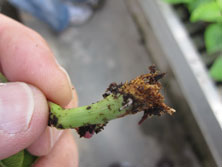12/27/2012
Fungus Gnats & Shoreflies: The Same, But Different
Dr. Roger Styer

Now that poinsettias are done for the year and growers are starting their plugs and liners for the coming season, one of the major problems growers see involves those pesky black flies in the propagation area. Most growers think they’re fungus gnats, but many times they’re shoreflies instead. Neither look like they’re damaging the young plants, but in reality, they both do in their own ways.
Pictured: Poinsettia with fungus gnat damage during the propagation stage.
Fungus gnat larvae feed on decaying organic matter, such as peat-based growing media, but will also feed on young roots and unrooted cutting stems. Sometimes they burrow into the base of the stem in contact with the soil, causing diseases such as Rhizoctonia to infect the plant. Other times, the larvae feed on roots, which causes less growth and can open up the young plant to root rots such as Pythium, Phytophthora and Fusarium.
Adults of both fungus gnats and shoreflies have been shown to move fungal spores of various root rots from plant to plant. Shorefly larvae feed on algae, but don’t cause damage to plants. Adults of both insects can leave unsightly spots on lower leaves. Young plant producers who sell to other growers must be keenly aware of controlling these two pests, as their customers do not want to see black flies coming out of boxes when they open up their newly arrived plugs or rooted liners. Growers who buy plugs or liners recognize that fungus gnats are not welcome in their shipments!
So, how do you know which insect you have? First, fungus gnat adults have a long thin body with long antennae and are lazy fliers. Fungus gnat adults tend to stay close to the soil surface, but will show up very well on yellow sticky cards placed 2 in. above the plants. The larvae have a black head capsule, while shorefly larvae do not. Second, shorefly adults have short, thick bodies with short antennae and are active fliers. They will jump up on your hands and arms when you wave them close to the trays.
The best way to monitor for these two insects is with yellow sticky cards, one placed every 500 to 1,000 sq. ft. of bench space. Another way to check for fungus gnats is to place potato slices, cut surface down, on the soil surface and check after a day or two. Fungus gnat larvae will flock to the potato slices. This method works best on pots and dirt floors.
Controlling fungus gnats and shoreflies requires an integrated approach. First, these insects love wet conditions. Keep floors and drains clean, practice good moisture management for plugs and liners, and control algae. I know this sounds easier said than done, but cultural practices will reduce problems with fungus gnats and shoreflies more than any chemicals or biological controls ever could. Algae crusts on the soil surface provide safe havens for shorefly larvae. Using too much mist during germination and rooting of cuttings makes the floors and drains great places for these insects to breed.
Second, controlling these insects chemically requires sprench applications to the soil surface to control the larvae. Some chemicals to use include Adept, Distance, any neonicotinoid (such as Marathon, Flagship and Safari), Citation, Pylon and Azatin. For controlling adults, it’s easy to spray for fungus gnats as they don’t fly very well, but shorefly adults will move away from the sprays and congregate on walls and roofs. The best method is to use fog or ULV to control adults of both. Decathlon, Talstar, Tame and Conserve work well. Make sure to follow all label instructions and only apply the amount of active ingredient required. Check for any phytotoxicity warnings on the label. Young seedlings can be exceptionally sensitive to certain chemicals that older plants would not.
Finally, more young plant producers are using biological controls successfully. Applying Botaniguard or a similar bioinsectide as a sprench or spray works well. Using nematodes during the wetter stages, such as germination and mist areas, will help control fungus gnats (Nemasys, Nemashield) and shoreflies (Millenium). Broadcasting Hypoaspis mites over trays and on ground floors will work against fungus gnats and thrips, but adding Atheta beetles gives good control of shoreflies as well. Work with your biological controls supplier to make sure you have proper distribution, frequency of application and the concentrations needed. Controlling these two pesky insects in propagation requires daily and weekly attention to the details, as they will always be around during the season.
GT
Dr. Roger Styer is Technical Specialist with Fides-Oro and can be reached on the company website. Go to www.fides-oro.com and click on “Ask the Doctor.”